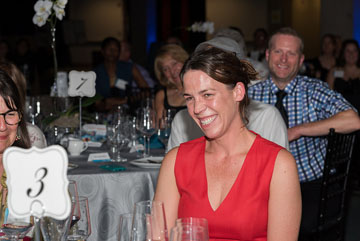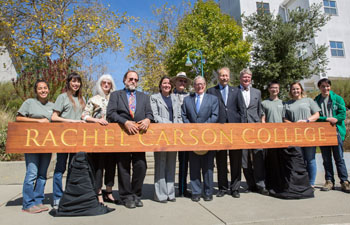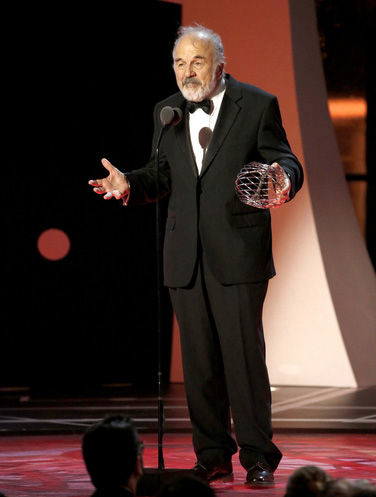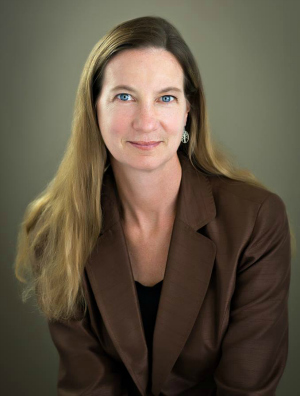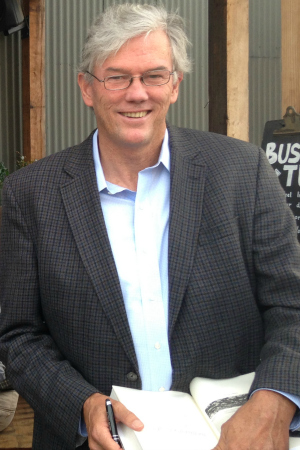The 12 months of 2016 were anything but typical at UC Santa Cruz. Students and faculty got creative, and took big, bold risks.
Consider, for instance, the early November groundbreaking ceremony for the campus’s beloved but long-shuttered Quarry Amphitheater, which is about to undergo an ambitious renovation program that will restore its former glory while updating this gathering spot for the 21st century.
The organizers of the ceremony could have taken the easy route by topping off the ceremony with a ribbon cutting and a few shovels full of dirt. Instead, Alison Galloway, in one of her final acts as campus provost and executive vice chancellor, brought the event to its conclusion by driving to the front of the amphitheater in a rumbling backhoe, then lowering the bucket loader to reveal the words “LET’S GET IT STARTED!”
This was just one of countless examples of UC Santa Cruz taking an unconventional path and standing out from the crowd. Here are a few other selected highlights.
Honoring her legacy
In one of the most well-attended and highly anticipated ceremonies of the year, College Eight, long known for its eco-minded students and projects, finally got a moniker worthy of its lofty mission.
In early October, the college was rededicated as Rachel Carson College, in honor of the environmental visionary who wrote the groundbreaking 1962 environmental science book Silent Spring. This was a fitting moment for a college that has fought long and hard to champion Carson’s values, with such projects as the Predatory Bird Research Group, which started off at an office in the college in 1975.
A naming gift from the Helen and Will Webster Foundation recognized Carson for her courage and pivotal role in awakening the public to environmental issues.
Collision spaces, generosity, and thinking big
When UC Santa Cruz held its 2016 Founders Celebration, recognizing excellence and generosity, it could have rented an auditorium somewhere. But that would have been a little too predictable. Instead, the organizers took the untried and true approach by turning the campus’s Science & Engineering Library into a thoughtful and upscale party space that was also a meeting of the minds.
This made sense, considering the library itself is now undergoing a thoughtful renovation that will update this space for the 21st century, turning it into a more interactive, wired, and lively campus hub, a place for a variety of thoughs and avenues of inquiry to "collide" and spark dynamic new ideas.
And speaking of collision spaces, UC Santa Cruz brought Julie Snyder (Kresge '95, politics), co-creator of the wildly successful Serial podcast, to campus to receive the Alumni Achievement Award. The podcast, which she created with cohort Sarah Koenig, is an exciting “collision” between old-fashioned reporting, the intimacy of interviews and storytelling, and cutting-edge technology.
Getting cosmic
In the scientific realm, UC Santa Cruz showed its grand ambitions, and got grand results and great recognitions in return.
UC Santa Cruz biologist Harry Noller capped off the year in a very big way when he won the $3 million Breakthrough Prize in Life Sciences for revealing how the molecular machines known as ribosomes translate genetic code and build proteins in all living cells. “Harry Noller has performed a tour de force in molecular biology for the past 50 years,” said UC Santa Cruz Chancellor George Blumenthal. “This recognition is well-deserved.”
In the same dramatic year, UC Santa Cruz astronomer Garth Illingworth and his collaborators continued to push the limits of current telescopes to study the most distant galaxies, breaking the record twice within a year.
The campus also continued to do its part in the war against a deadly and pernicious disease by suggesting treatment options for prostate cancer and getting crucial support for its Treehouse Childhood Cancer Initiative.
Meanwhile, scientists did a fine job of showing the strong economic benefits of habitat preservation with a study showing that coastal wetlands save hundreds of millions of dollars in flood damages during hurricanes.
Some of the scientific findings were sobering for anyone who is concerned with the health of our planet. Take, for example, a study showing that the current rate of carbon emissions is unprecedented in the past 66 million years. Meanwhile, a study drew links between nitrogen pollution threats and endangered species.
But there was also encouraging and even uplifting news on the environmental front. Scientists also did a fine job of showing that island creatures can be protected from extinction, especially when invasive and voracious critters are removed from those islands.
And speaking of environmental boons on campus, UC Santa Cruz got high honors for its sustainability practices in Sierra, the magazine published by the Sierra Club, the mighty environmental organization whose founders included John Muir. Cool school, indeed!
UC Santa Cruz also proved that “gold is the new green” by getting a gold rating for sustainability from the Association for the Advancement of Sustainabilty in Higher Education.
Artistic riches and creative visionaries
UC Santa Cruz excelled in the sciences, but it also made its mark in the arts and humanities. This fall, the campus received an extraordinary windfall—the photography collection of Pirkle Jones and Ruth-Marion Baruch, plus works by Ansel Adams, Dorothea Lange, and Edward Weston, valued at $32 million—a treasury of photographs like no other.
And it looks like the word about a few of our best-kept cultural secrets has been getting out in a big way. UC Santa Cruz also received $1 million to support the Institute of the Arts and Sciences, and a film by a UC Santa Cruz art professor got nominated for an Academy Award.
And who says arts and humanities belong inside an ivory tower? Creative-minded people on campus had many "straight off the headlines" moments this year, whether they were leading a talk about anger in politics from Shakespeare to Trump or contributing to Time magazine’s “25 moments that changed America.”
Meanwhile, creativity, history, and technology helped shine a new light on a tragic corner of the past when a history professor created a new public database about the slave trade. Faculty also gazed into the future, wondering what life might be like for pedestrians when self-driving cars become the norm instead of novelties.
The Slugs are back!
This was also a year for even more student success. The campus saw growth in enrollment and welcomed a more diverse group of incoming first-year students as well as transfer students as part of a UC-wide plan to enroll 5,000 more undergraduates. The campus also embarked on an equity initiative for Latino, low-income students in STEM fields.
Alumni Slugs also got their day in the sun. Martha Mendoza (Kresge, ’88, independent major, journalism and education) and William Finnegan (Cowell, '74, English literature) both won Pulitzer Prizes.
And speaking of Slugs in high places, a Ph.D. graduate in international economics became the incoming deputy managing director of the International Monetary Fund.
With 2016 bursting with accomplishments, recognitions, and accolades for UC Santa Cruz, we can't wait to see how the campus builds on its success in the year ahead.

